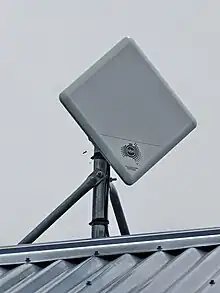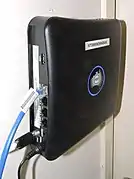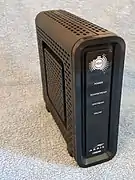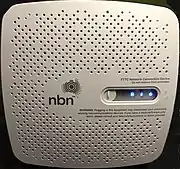Network Termination Device (NBN)
A Network Termination Device (NTD) is a customer-side network interface device used by the Australian National Broadband Network (NBN). Network termination devices provide multiple bridges for customers to access the NBN. There are different types of NTDs for the various connection technologies encompassed by NBN. All connection types except FTTN use NTDs on premises. Depending on the kind of link, NTDs typically provide two telephony and four data channels.[1] An external power source is required, and an uninterruptible power supply (UPS) can be used to maintain connection in power outages (battery backups are available for the FTTP NTD). FTTC requires power to be provided from the premises to the kerb (distribution point).
NTDs provide user–network interface (UNI) connections for connection of in-premises devices. They typically have multiple RJ45 jacks for the UNI-D (data) connection, and some models have RJ11 jacks for the UNI-V (voice) connection. All NTDs are capable of passing VoIP traffic. FTTN requires premises to have a compatible VDSL2 modem. Each UNI-D port can be activated by retail service providers for different NBN services. The NTD cannot be used as a Layer 3 router for in-premises networking.[2]
Most devices used in NBN are produced by Alcatel-Lucent, currently a division of Nokia Corporation. In FTTC networks, the hardware from domestic manufacturers CASA Systems (formerly NetComm) and Adtran are used (noting that the device is formally called an NCD), and in HFC networks from Arris, currently a division of CommScope. FTTN networks, based on VDSL2 technology, can be accessed with any compatible modem or router that supports VDSL2. NBN itself doesn't sell any VDSL2-compatible hardware and it must be supplied by end-user of the network.
Network technologies
| Technology | Model | Upstream protocol | UNI-V jacks | UNI-D jacks | Alternative names | Notes |
|---|---|---|---|---|---|---|
| FTTP | Alcatel-Lucent | GPON | 2 | 4 | ||
| FTTB/N | None (end-user modem) | VDSL2 | 0 | 0 | VDSL2 modem | The UNI for a FTTB/N service is a copper pair termination in the premises (at at the building MDF) carrying a VDSL2 signal. UNI-V or UNI-D style functionality is provided by the CPE modem/router supplied by the customer or end user. |
| FTTC | Casa Systems (previously NetcommWireless) NDD-0300[3] | VDSL2 | 0 | 1 | Network connection device (NCD) or FTTC connection device.[4] FTTC was previously known as fibre to the distribution point (FTTdp). |
|
| HFC | Arris CM8200(B) | DOCSIS 3.0 | 0 | 2 | Cable modem | Only one UNI-D port (UNI-D 1) is supported for use. |
| Fixed wireless | Alcatel-Lucent | LTE | 0 | 4 | NBN connection box or indoor unit (IDU) or 4G modem | Where a plain old telephone service (POTS) is in place, this can be kept |
| Satellite | ViaSAT Residential Broadband Terminal 1240 | 0 | 4 | Indoor unit (IDU) |
|
Gallery
 FTTP NTD (cover removed), showing Ethernet, power and fibre connections
FTTP NTD (cover removed), showing Ethernet, power and fibre connections Fixed wireless NTD
Fixed wireless NTD Fixed wireless outdoor unit (ODU) antenna (paired with the NTD)
Fixed wireless outdoor unit (ODU) antenna (paired with the NTD) Satellite NTD
Satellite NTD HFC Cable Modem (NTD)
HFC Cable Modem (NTD) FTTC VDSL Modem (NTD)
FTTC VDSL Modem (NTD)
References
- "Residential preparation and installation: Single Dwelling Units (SDUs) and Multi Dwelling Units (MDUs)" (PDF). NBN Co. 12 December 2016. Retrieved 21 August 2019.
- "nbn Fibre to the Curb explained". NBN Co. Retrieved 21 August 2019.
- Corinne Reichert, (4 December 2017), NetComm Wireless unveils FttC network connection device, ZDNet
- ""FTTC Connection Device" = fancy way of saying "Standalone VDSL2 modem"?". TPG Community. September 2018. Retrieved 21 August 2019.
- "Network Design Rules" (PDF). NBN Co. 29 June 2018. p. 49. Retrieved 21 August 2019.